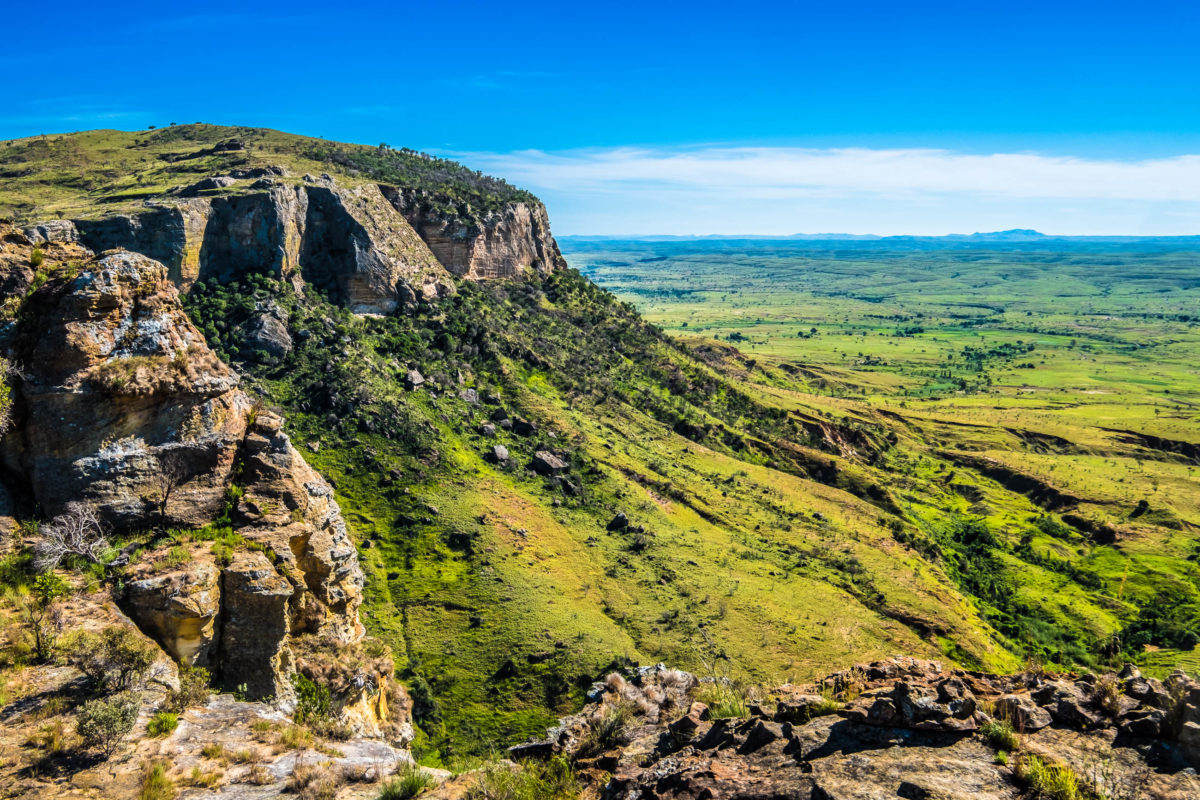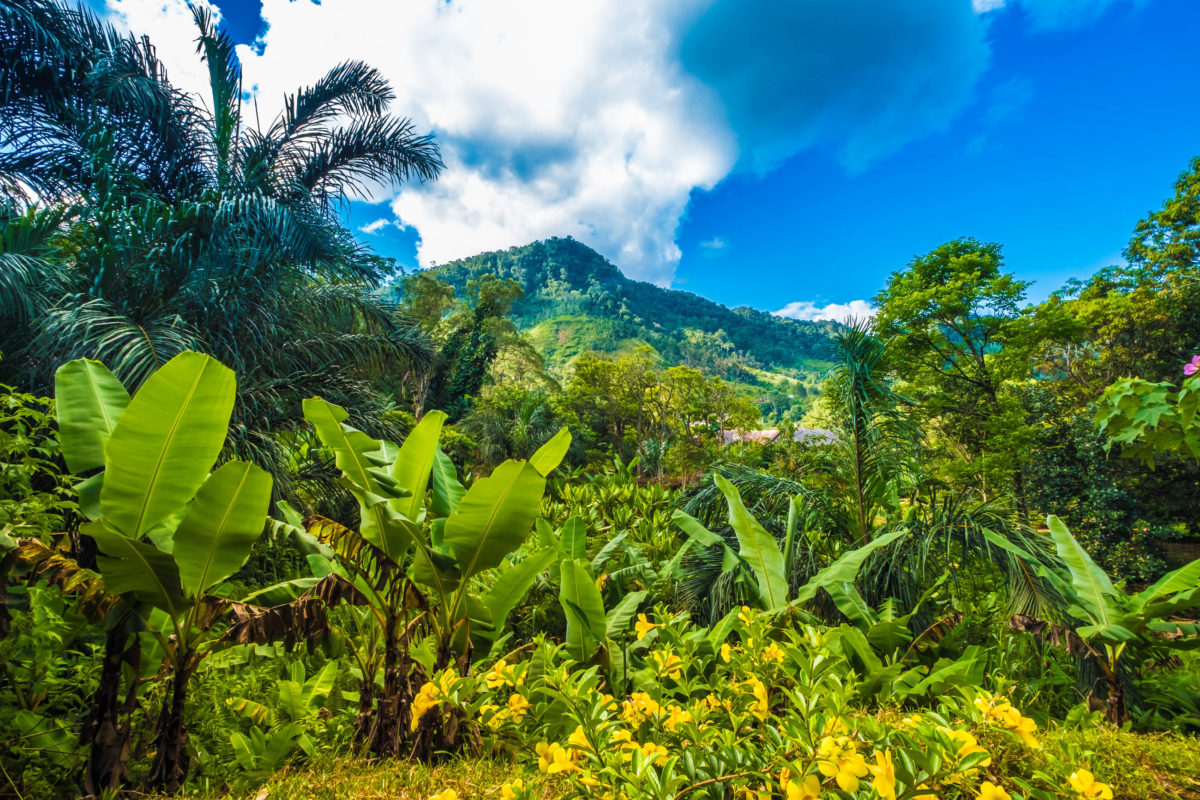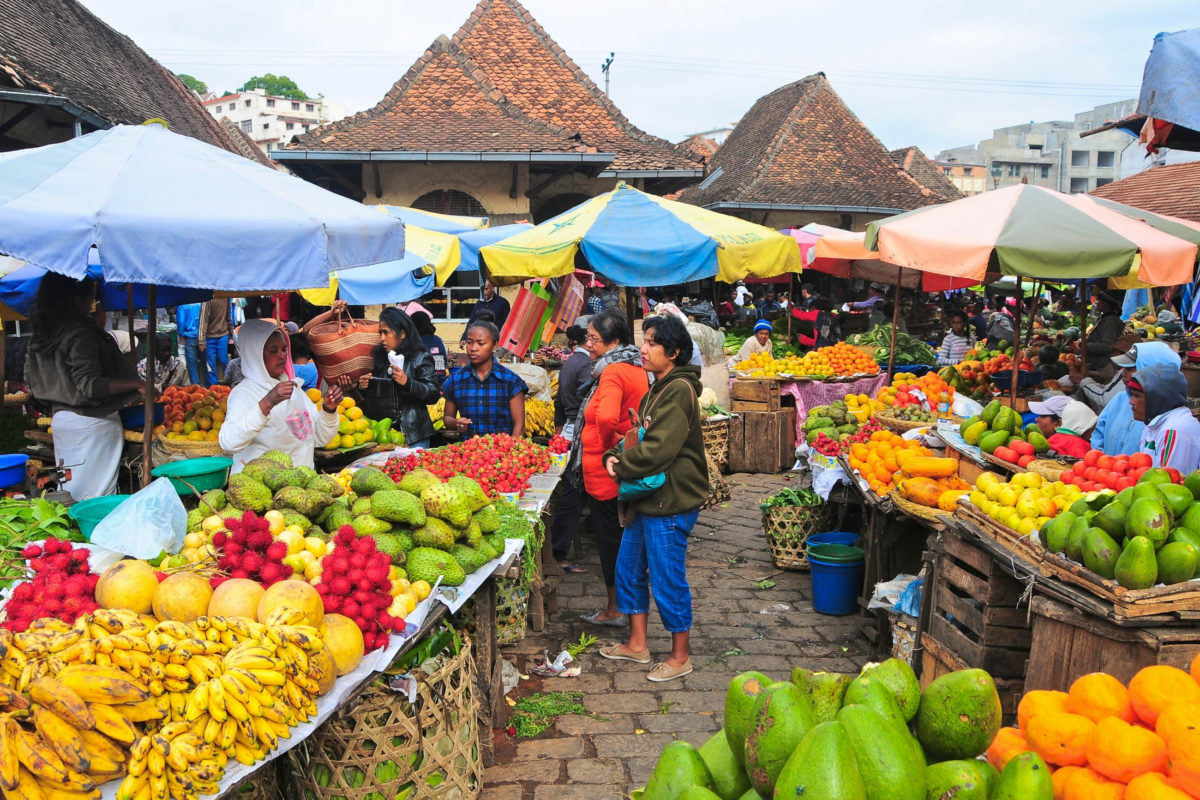Welche Highlights und Attraktionen dürfen Sie beim Urlaub in Madagaskar auf keinen Fall versäumen? Hier finden Sie eine Liste der Top 10 Sehenswürdigkeiten von Madagaskar!
Spätestens seit dem Animationsfilm „Madagaskar“ ist der zweitgrößte Inselstaat der Welt (nach Indonesien) den meisten Menschen ein Begriff. Für Reisende, die gerne exotische Länder besuchen, in denen der Massentourismus noch in den Kinderschuhen steckt, sollte Madagaskar unbedingt auf der Bucket List stehen.
Dschungel, Lemuren und unaussprechliche Namen: Auf Madagaskar beeindrucken Gräber und Paläste vergangener Könige, tropische Regenwälder mit unbekannten Tierarten, traumhafte Strände und eine unberührte Unterwasserwelt. Die moderne Hauptstadt Antananarivo liegt gleich neben Ambohimanga, dem majestätischen Hügel des Königs und alte Hauptstadt Madagaskars.
Die beste Reisezeit für Madagaskar liegt zwischen April und Oktober, wobei im Juli die Hauptsaison startet. Von November bis März herrscht Regenzeit und vor allem im Jänner und Februar wird die Ostküste häufig von Tropenstürmen heimgesucht. Luft- und Wassertemperatur liegen im tropischen Klima Madagaskars das ganze Jahr über um die 30 °C.
Madagaskar ist ein facettenreiches Land der Gegensätze und lockt ebenso zu Aktivurlaub in den Bergen und Nationalparks wie zu Erholungsurlaub an den paradiesischen Küsten und einsamen Inselchen. Ebenso vielschichtig sind auch unsere Top 10 Sehenswürdigkeiten von Madagaskar, die bestimmt jeden Reise-Geschmack treffen!
Inhaltsverzeichnis
Vulkanfelder

Bis noch vor 12.000 Jahren war Madagaskar eine karge Felseninsel, deren fünf Vulkane durch regelmäßige Ausbrüche kaum Leben ermöglichten. Seit Ruhe herrscht, wurde die tropische Insel im Indischen Ozean von dichten Wäldern mit zahlreichen Tier- und Pflanzenarten überwuchert. Die Überreste der vulkanischen Aktivität aus dem Pleistozän sind anhand von fünf Vulkanfeldern unübersehbar.
So gibt es zum Beispiel um den Kratersee Itasy, Madagaskars drittgrößten See, unzählige Geysire, rauchende Erdlöcher, heiße Quellen und erloschene Vulkankrater zu sehen. Ebenso gibt es um den Ankaratra, den zweithöchsten Berg der Insel, erstarrte Lava und Kraterseen zu bestaunen.
Die Vulkanfelder Ankaizina und Ambre-Bobaomby im Norden von Madagaskar bieten heute bedrohten Vogelarten und verschiedensten Lemurenarten eine Heimat mit kochend heißer Vergangenheit. Das fünfte Vulkanfeld von Madagaskar liegt auf der Insel Nosy Be ebenfalls im Norden der Insel. In seinen Kraterseen, die als heilige Stätte der Ahnen gelten, haben sich mittlerweile Krokodile angesiedelt.
Artikel: Die 5 Vulkanfelder Madagaskars
Morondava und die Baobab-Allee

Neben den Vulkanfeldern sind die riesenhaften Baobabs die zweite Sehenswürdigkeit, die Madagaskar so besonders macht. Besonders spektakulär präsentieren sich die scheinbar verkehrt gewachsenen Baumriesen an der Westküste Madagaskars bei Morondava.
Ihre dicken Stämme mit den charakteristischen knorrigen Ästen ragen rund 45 Autominuten von der Küstenstadt entfernt links und rechts der Straße nach Belo Tsiribihina in den Himmel.
Tipp: Im Februar und März sind die Baobabs (oder Affenbrotbäume) besonders hübsch anzusehen – dann blühen sie nämlich.
Abgesehen von der Baobab-Allee hat Morondava („wo die Küste lang ist“) auch paradiesische Strände mit viel Sonne in entspannter Urlaubs-Atmosphäre zu bieten. Vom Baden ist in Morondava aufgrund der Strömungen allerdings leider abzuraten.
Artikel: Morondava und die Baobab-Allee
Nationalpark Tsingy de Bemaraha

Morondava ist auch ein perfekter Ausgangspunkt für einen Besuch des Nationalparks Tsingy de Bemaraha. Sein Name bedeutet frei übersetzt „wo man nicht barfuß gehen kann“. Wer die einzigartige Karstlandschaft des Nationalparks zu Gesicht bekommt, weiß auch sofort, woher diese Bezeichnung stammt. Unzählige steinerne Spitzen, zum Teil von Wind und Wetter messerscharf geschliffen, bedecken den gesamten Nationalpark wie ein spektakulärer Wald aus Felsnadeln.
Abgesehen von den bizarren Felsformationen ist auch die Tier- und Pflanzenwelt im Tsingy de Bemaraha Nationalpark einmalig. Über 80 Prozent der Pflanzen gedeihen sonst nirgends auf der Welt. In den stachelig-trockenen Wäldern des Hochlandes und den feuchten Seengebieten der Täler leben 100 Vogelarten und 13 verschiedene Lemuren.
Die Labyrinthe als Kalkstein mit ihren Höhlen, Schluchten und Plateaus können auf Wanderwegen oder per Rundflug erkundet werden.
Artikel: Nationalpark Tsingy de Bemaraha
Fotogalerie: Nationalpark Tsingy de Bemaraha
Nationalpark Isalo

Auch der Isalo Nationalpark im südlichen Hochland Madagaskars besticht durch seine bizarren Felsformationen aus Jura-Sandstein. In den weiten Savannen und Grasebenen zischen die possierlichen Kattas umher und in den Büschen gibt es Chamäleons zu entdecken.
Der 1962 gegründete Park liegt direkt an der RN7 und ist mit dem Auto daher leicht zu erreichen. Die Wanderwege durch den 80.000 Hektar großen Isalo Nationalpark sind allesamt gut erschlossen und reichen von wenigen Stunden bis zu mehreren Tagen.
Tipp: Wer den Nationalpark mit dem Auto erkunden möchte, sollte unbedingt über einen Geländewagen mit Allradantrieb verfügen!
Eine der Hauptattraktionen des Isalo Nationalparks sind seine natürlichen Pools. Blue Pool, Black Pool und der absolut malerische Piscine Naturelle laden nach einer Wanderung durch die imposante Berglandschaft zu einem erfrischenden Sprung ins kühle Nass ein. Ebenfalls Abkühlung verschaffen die bis zu 200 Meter tiefen Canyons des Parks oder eine Wanderung zu einem der Wasserfälle.
Nationalpark Ranomafana

Im Ranomafana Nationalpark sind nicht die Bergrücken und Felsen die Attraktion, sondern die üppig grünen Bergregenwälder. Nirgendwo sonst auf Madagaskar können Wanderer besser in die wilde tropische Natur des Inselstaates eintauchen. Lemuren huschen durch die Baumwipfel, Geckos schnappen nach Schmetterlingen und exotische Blüten säumen die Wanderwege, die auf bis zu 4 Tage dauernden Touren erforscht werden können.
Mitten im drittgrößten Nationalpark Madagaskars liegt ein Kurhotel, welches die natürlichen Thermalquellen zu Entspannungs- und Heilzwecken zugänglich macht. Diese gaben dem Nationalpark übrigens auch seinen Namen, denn Ranomafana bedeutet „heißes Wasser“.
Beste Reisezeit für den Romafana Nationalpark ist das ganze Jahr über, im August ist allerdings mit am wenigsten Niederschlag zu rechnen. Das tropische feucht-heiße Klima ändert sich dagegen kaum.
Insel Nosy Be

Die Insel Nosy Be rund 10 Kilometer vor der Nordküste Madagaskars ist nicht nur aufgrund ihrer turbulenten vulkanischen Überbleibsel eine Reise wert. Die „Große Insel“ zählt zu den beliebtesten Touristenzielen auf Madagaskar und wird aufgrund seiner Zucker-, Vanille-, Nelken- und Zimtplantagen auch „Parfum-Insel“ genannt.
Etwa so groß wie die deutsche Insel Rügen gibt es auf Nosy Be lediglich um die 350 Gästezimmer, die lange im Voraus ausgebucht sind. Wer eine Unterkunft ergattert, wird mit einem Traumurlaub im Paradies fern vom Massentourismus belohnt.
Denn Nosy Be ist eine perfekte Ferieninsel, auf der sich die Temperaturen ganzjährig zwischen 20 und 30°C bewegen. Trotzdem ist Nosy Be dank den häufigen (meist nächtlichen) Regenfällen üppig grün und kann mit atemberaubender Natur aufwarten. Herrliche Sandstrände, tropische Naturreservate, rauschende Wasserfälle und Kraterseen mit Krokodilen sowie die Bars und Discos von Ambataloaka formen eine bunte Mischung an Aktivität und Unterhaltung, die Urlaub auf Nosy Be so besonders macht.
Insel Nosy Boraha

Die einstige Piraten-Insel Nosy Boraha an der Nordostküste von Madagaskar ist ebenso wie Nosy Be ein traumhaftes Urlaubsparadies, allerdings um einiges ursprünglicher.
Goldgelbe Sandstrände in palmengesäumten Buchten locken zu Badeferien und ein glasklares Meer komplett mit Korallenriff offenbart Tauchern und Schnorchlern die faszinierende Unterwasserwelt Madagaskars.
Tipp: Im Juni und September ziehen hier sogar Buckelwale vorbei. Sie verlassen die kalten Gewässer der Antarktis, um weiter nördlich ihre Kälber zur Welt zu bringen und kehren einige Monate später wieder zurück.
Königspalast (Rova) in Ambohimanga

Rund 20 Kilometer nördlich der madagassischen Hauptstadt Antananarivo befindet sich die historische Hauptstadt Ambohimanga. In der besterhaltenen Palastanlage von Madagaskar hatten bis ins späte 18. Jahrhundert die Könige des Inselstaates ihren Sitz. Seit 2001 zählt die heute heilige Stätte zum Weltkulturerbe der UNESCO.
Vom 15. bis ins 19. Jahrhundert wurde an Ambohimanga gebaut. Rund um den Königspalast, den eher schlicht gehaltenen „Rova“, entstanden auf dem Palastgelände das königliche Bad, ein Opferplatz, ein Gerichtsstuhl sowie die Grabstätten der Könige. Die Überreste davon sind heute noch zu sehen und machen Ambohimanga nach wie vor zu einem wichtigen Pilgerziel, an dem die Madagassen ihre verflossenen Herrscher um Hilfe und Rat fragen.
Königspalast (Rova) in Antananarivo

Auch in Antananarivo liegt ein Rova, ein madagassischer Königspalast. Er wurde im 17. Jahrhundert erbaut, als der Regierungssitz Madagaskars von Ambohimanga nach Antananarivo verlegt wurde. Ab dann war der stark befestigte Palast rund 300 Jahre das kulturelle und politische Zentrum des erst kürzlich geeinten Reiches.
Der Rova liegt auf 1.500 Metern Höhe rund 200 Meter über Antananarivo und bietet einen fantastischen Blick auf die Stadt. Paläste, Tempel, Wohnhäuser, eine Kapelle und die Grabstätten der Königsfamilie sind auf den sieben heiligen Hügeln bis heute zu besichtigen. Der Großteil der Holzbauten wurde 1995 durch ein Feuer zerstört, erst 2010 wurde der Königspalast nach der Renovierung wieder für Besucher eröffnet.
Seit 2020 thront auf den Grabstätten der Könige ein (kontrovers diskutiertes) Kolosseum, welches vor einem 400 Menschen fassenden Publikum eine fantastische Kulisse für kulturelle Veranstaltungen bietet.
Analakely Market in Antananarivo

Neben dem Königspalast ist der Analakely Markt die zweite berühmte Sehenswürdigkeit in Antananarivo. Er ist der größte Markt der Stadt und auch als Zoma Market bekannt. Auf dem Analakely Markt ist immer was los, denn in den bunten Pavillons finden die Einheimischen alles, was sie für das tägliche Leben brauchen.
Obst und Gemüse in leuchtenden Farben, Fisch, Fleisch (wer hat Lust auf gegrillte Eidechsen?) und Kleidung machen den Großteil der feilgebotenen Waren aus. Auch Haushaltswaren, Elektronik und DVDs sind verfügbar, ebenso wie afrikanisches Kunsthandwerk.
Wer auf der Suche nach Souvenirs ist, ist hier ebenfalls richtig, handeln und feilschen steht hier an der Tagesordnung – leider ebenso wie Taschendiebstahl, deshalb die Wertsachen besser im Hotel lassen.




